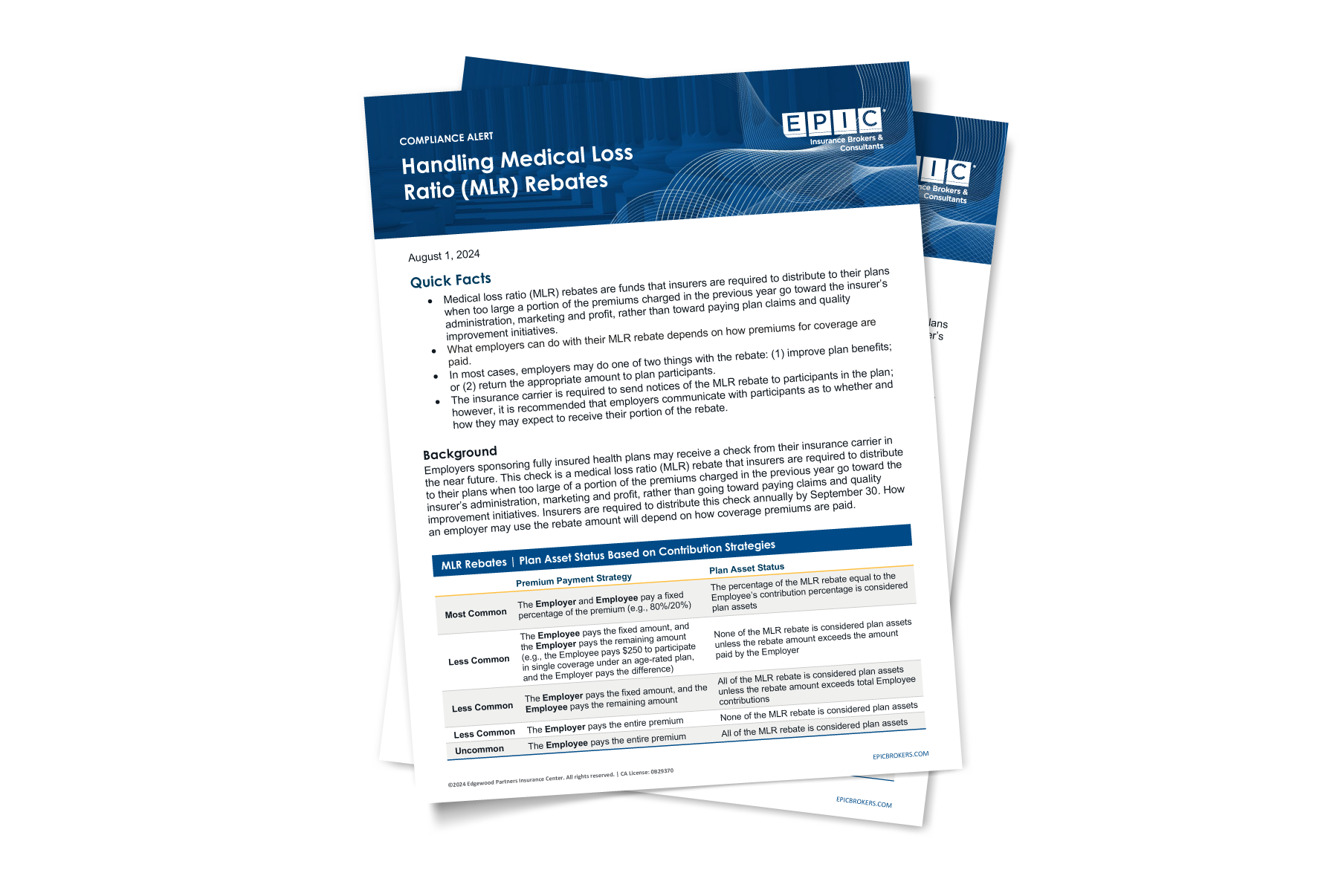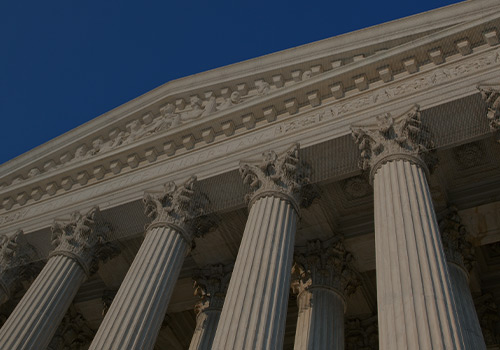Let our team help you navigate the ever-changing benefits compliance landscape each month. Check out this month’s latest alerts, additional updates, and resources hot off the press:
Employee Benefits Compliance Alerts
This month’s Compliance Matters newsletter provides a comprehensive review of the following topics. To obtain your copy, please use the form below to download.

- Departments Release Final Rules for Mental Health Parity
- EBSA Provides Clarity on Cybersecurity Best Practices
- FTC Files Lawsuit Against the Big Three PBMs
- 2024 State Regulation Series: Advances in California Long-Term Care Program
- 2024 State Regulation Series: Massachusetts Health Care Reform
Download this month’s alerts
Additional Updates & Resources
Reminder – New Fixed Indemnity Model Notice
The Departments of Health and Human Services (HHS), Labor, and the Treasury (collectively, the Departments) released final rules earlier this year that establish a new requirement to provide a consumer notice regarding Fixed Indemnity Excepted Benefits and Short-Term, Limited-Duration Insurance (STLDI) coverage in the group market. Access our May 2024 Alert for more information. As part of the Final Rule, Group Plan Sponsors must provide the new consumer notice for plan years starting on or after January 1, 2025.
The model notice has specific content and formatting requirements and must be provided to eligible individuals before they enroll or reenroll in fixed indemnity benefits. While the notice may be provided with other materials, it must be displayed prominently to ensure plan participants recognize it. The notice must appear on the first page of any marketing, application and enrollment (or reenrollment) materials, whether in paper or electronic form, in at least 14-point font. What constitutes marketing, application, and enrollment materials that must include the notice is often fact-specific. The regulations’ preamble indicates marketing materials “include any documents or website pages that advertise the benefits or offer an opportunity to enroll (or reenroll) in group market fixed indemnity excepted benefits coverage.”
For stand-alone materials that only reference or discuss the hospital indemnity plan, the notice must appear on the first page of those materials before any other information. Where the information on the hospital indemnity plan is bundled with information on other benefits (e.g., in a benefit guide), the agencies have acknowledged it will often be clearer if the notice appears in the guide immediately before the information on the hospital indemnity plan rather than the first page of the bundled material where it may not be obvious as to which plan the notice applies.
In the case of electronic materials, like an online enrollment portal, it should be sufficient if the notice appears on the screen immediately before or on the same screen as where the employee actually enrolls in the hospital indemnity plan. The regulations indicate it is not sufficient to merely include a link employees can click to access the notice; the notice itself must be displayed in the portal immediately before the place where the employee enrolls in the benefit.
The model notice can be found within the Final Rules.
ACA Affordability Percentage for 2025
Through Revenue Procedure 2024-35, the Internal Revenue Service (IRS) updated the Affordable Care Act (ACA) affordability percentage from 8.39% in 2024 to 9.02% for 2025. This percentage determines which applicable large employers (ALEs) may face penalties under ACA §4980H(b) for failure to offer affordable coverage, as well as which individuals may qualify for subsidized coverage through a public Exchange. When setting plan contribution rates, employers must consider IRS employer affordability safe harbors, the various elements that play into determining employee contribution and the penalties for failing to offer affordable coverage.
Under §4980H (the employer mandate), ALEs (50 or more full-time equivalents [FTEs]) must offer coverage to full-time employees that is affordable to avoid potential penalties. In addition, individuals enrolling in coverage through a public Exchange will not qualify for subsidized coverage (premium tax credits) if they are eligible for employer-sponsored group health plan coverage that is affordable.
Coverage is considered “affordable” if the required employee contribution does not exceed a set percentage (9.02% in 2025) of household income.
- For employees, coverage is affordable if the required employee contribution for the lowest cost minimum value plan for employee-only (single) coverage is affordable.
- For spouses and dependents, coverage is affordable if the required employee contribution for the lowest cost minimum value plan for family coverage is affordable. Note that penalties under ACA for failure to offer affordable coverage do not apply to spouses and dependents.
Coverage is also considered “affordable” under employer mandate requirements if the employee contribution satisfies at least one of three available safe harbors (i.e., federal poverty level [FPL]), rate of pay, or Form W-2). However, it is not always financially advantageous for the employer to ensure that the coverage offered is affordable to all full-time employees. Employers should consider the §4980H(b) monthly penalty for a full-time employee receiving a subsidy. The employer contribution for employees who enroll in the employer’s plan may be more than the employer would be required to pay as a penalty under §4980H(b).
IRS Private Letter Ruling Allows Employee Allocation of Funds Outside the Cafeteria Plan
In private letter ruling (PLR) PLR 202434006, the Internal Revenue Service (IRS) concluded that an employer may allow employees to allocate non-elective, discretionary employer contributions among a 401(k) plan, retiree health reimbursement arrangement (HRA), health savings account (HSA) or educational assistance program (EA Program) without jeopardizing the tax advantages offered under these programs.
The letter, dated May 20, 2024, responds to a letter dated April 3, 2024, in which the Taxpayer proposes to amend these tax-advantaged programs to allow eligible employees the choice to allocate an employer contribution of a certain percent of compensation among these programs.
The IRS concludes that the proposal would not create an additional cash or deferred compensation arrangement under IRS Code § 401(k) because it would not permit employees to choose between having the employer contribution paid in cash or contributing it to a deferred compensation plan. Therefore, the employer contribution was not an employee pre-tax contribution subject to the annual elective deferral limitation. The letter goes on to state that the HRA would still meet applicable HRA requirements and that employee allocation of funds to their HSAs would still be excludable from their gross income so long as the contributions do not exceed the IRS statutory limits for HSAs. The letter concludes by determining that the proposed amendment does not affect the treatment of payments from an EA Program as excludable from gross income subject to the IRS Code statutory limit and, therefore, would not disqualify the EA Program under the IRS Code
California Updates Payroll Tax for Short-Term Disability
Annually, the California Employment Development Department (EDD) updates the California state disability insurance (SDI) contribution rate. Starting January 1, 2025, California is projected to increase the SDI contribution rate from 1.1% in 2024 to 1.2% in 2025. As a reminder, the taxable wage ceiling for state disability insurance was removed in 2024. Access our July 2023 Alert on this change.
Additionally, beginning in 2025, California SDI benefits will cover 90% of wages for low-wage workers and 70% up to a cap for other workers. These benefit amounts are adjusted periodically for inflation, and the increases are intended to provide support for lower-wage earners in California.
San Francisco OLSE Updates 2025 HCSO Expenditure Rates
Recently, the San Francisco Office of Labor Standards Enforcement (OLSE) updated the health care expenditure (HCE) rates used to determine the health care security ordinance (HCSO) expenditure requirement for 2025. As of January 1, 2025, the required HCE amount to satisfy the HCSO expenditure requirement for large businesses (those with 100 or greater workers) will be $3.85 per payable hour on behalf of all covered employees, an increase from the 2024 rate of $3.52 per employee per hour. For medium-sized businesses (those with 20 to 99 workers), the HCE will be $2.56 per payable hour on behalf of all covered employees, an increase from the 2024 rate of $2.34 per employee per hour. Employers with less than 20 employees are exempt from the HCSO expenditure requirement. The 2025 exemption threshold for managerial, supervisorial, or confidential workers will be $125,405 annually (or $60.29 hourly).

More Compliance Resources
- Sign up for our in-depth 2024 Compliance Webinars
- Learn about our Compliance Consulting Services

WANT TO GET COMPLIANCE MATTERS IN YOUR INBOX?
Sign up for the monthly newsletter.
